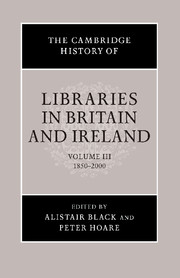Book contents
- Frontmatter
- Introduction: sources and methodologies for the history of libraries in the modern era
- 1 Libraries and the modern world
- Part One Enlightening the Masses: the Public Library as Concept and Reality
- Part Two The Voluntary Ethic: Libraries of our Own
- Part Three Libraries for National Needs: Library Provision in the Public Sphere in the Countries of the British Isles
- Part Four The Nation's Treasury: Britain's National Library as Concept and Reality
- Part Five The Spirit of Enquiry: Higher Education and Libraries
- Part Six The Rise of Professional Society: Libraries for Specialist Areas
- Part Seven The Trade and its Tools: Librarians and Libraries in Action
- 39 Introduction: librarians and libraries in action
- 40 The interpretation of professional development in librarianship since 1850
- 41 Education for librarianship
- 42 Women and Libraries
- 43 The feminisation of librarianship: the writings of Margaret Reed
- 44 Sharing the load: libraries in co-operation
- 45 Organising knowledge: cataloguing, classification and indexing in the modern library
- 46 Storehouses of knowledge: the free library movement and the birth of modern library architecture
- Part Eight Automation Pasts, Electronic Futures: the Digital Revolution
- Bibliography
- Index
- References
41 - Education for librarianship
from Part Seven - The Trade and its Tools: Librarians and Libraries in Action
Published online by Cambridge University Press: 28 March 2008
- Frontmatter
- Introduction: sources and methodologies for the history of libraries in the modern era
- 1 Libraries and the modern world
- Part One Enlightening the Masses: the Public Library as Concept and Reality
- Part Two The Voluntary Ethic: Libraries of our Own
- Part Three Libraries for National Needs: Library Provision in the Public Sphere in the Countries of the British Isles
- Part Four The Nation's Treasury: Britain's National Library as Concept and Reality
- Part Five The Spirit of Enquiry: Higher Education and Libraries
- Part Six The Rise of Professional Society: Libraries for Specialist Areas
- Part Seven The Trade and its Tools: Librarians and Libraries in Action
- 39 Introduction: librarians and libraries in action
- 40 The interpretation of professional development in librarianship since 1850
- 41 Education for librarianship
- 42 Women and Libraries
- 43 The feminisation of librarianship: the writings of Margaret Reed
- 44 Sharing the load: libraries in co-operation
- 45 Organising knowledge: cataloguing, classification and indexing in the modern library
- 46 Storehouses of knowledge: the free library movement and the birth of modern library architecture
- Part Eight Automation Pasts, Electronic Futures: the Digital Revolution
- Bibliography
- Index
- References
Summary
1850–1939: The Establishment of Professional Control
When they surveyed the late nineteenth-century scene of triaining and education in the expanding victorian library, the founding members of the Library Association (LA) perceived an eclectic mix of written manuals, ad hoc classes of instruction and apprenticeship arrangements. Some practising librarians claimed that these arrangements worked well. However, others argued that they failed to provide any guarantee of the competence of librarians and presented a somewhat chaotic and amateur impression of the profession to the outside world. Most senior members of the newly formed association agreed with Henry Tedder, at the annual meeting of 1882, when he urged that the LA needed to embark on a quest for status, respectability and professionalism. For this, he claimed, ‘some form of preparatory examination is obligatory… many other bodies of professional men have taken steps in the like direction’.
The association swiftly set about the erection of such an examination system. A committee on library training was established, and it soon developed a series of examinations with three levels of award. The initial preliminary examination in 1885 tempted only three candidates. However, modifications gradually attracted more, especially those of 1904, which established the intermediate level of award as the benchmark for a professional librarian. By 1906 entry levels stood at ninety-eight and by 1914 at 302. In essence, despite changes of syllabus in 1920 and 1933, this system of examinations continued until World War II as the main measure of competence in the emerging library profession.
- Type
- Chapter
- Information
- The Cambridge History of Libraries in Britain and Ireland , pp. 534 - 542Publisher: Cambridge University PressPrint publication year: 2006
References
- 2
- Cited by



